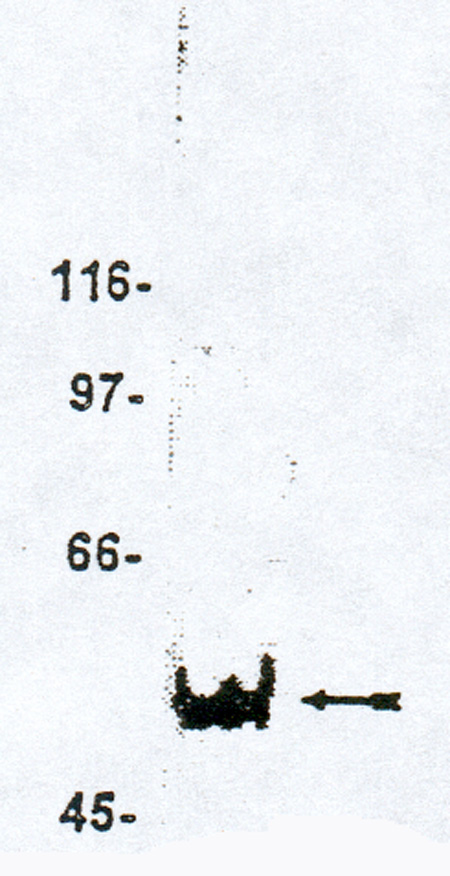
Rabbit anti Human Lysophosphatidic Acid Receptor 1 CT (EDG-2)
Catalog number: C174P| Isotype | IgG |
| Product Type |
Polyclonal Antibody |
| Units | 100 µg |
| Host | Rabbit |
| Species Reactivity |
Human |
| Application |
Western Blotting |
Background
Endothelial cell differentiation gene-2 (EDG-2) receptor is a high affinity receptor for lysophosphatidic acid (LPA). EDG-2, also known as lysophospholipid receptor A1, Vzg-1, mrec1.3 or GPCR26, like all other EDG receptors, couple multiple (3 or more) types of G proteins and transduce decreases in c[AMP]i through Gi and increases in [Ca2+]i by augmenting phospholipase C through Gq/11 and beta/gamma dimers and by induction of PI3 kinase, p125 FAK, phospholipase D by activating rho through G12/13. Human EDG-2 is present in high levels on oligodendrocytes and certain human malignant T cell lines. EDG-2 receptors (with EDG-4) may play a role in protecting cardiomyocytes from apoptosis induced by hypoxia and andrenergic stimulation.
Synonyms: Endothelial Cell Differentiation Gene Receptor 2; Lysophosphatidic Acid Receptor 1
Source
Immunogen: Synthetic peptide derived from the C terminal of the EDG2 receptor.
Product
Product Form: Unconjugated
Formulation: Provided as solution in phosphate buffered saline with 0.08% sodium azide
Purification Method: Ammonium Sulfate Precipitation
Concentration: See vial for concentration
Applications
For Western blotting, starting dilution of 5-10 µg/ml is recommended. Western blot should be visualized using a high sensitivity secondary/substrate system (i.e. Pierce’s SuperSignal West Femto Maximum Sensitivity Substrate). Optimal concentration should be evaluated by serial dilutions.
Functional Analysis: Western Blotting
Positive Control: RH7777 Cells Transfected with EDG2/LPA1protein
Storage
Product should be stored at -20°C. Aliquot to avoid freeze/thaw cycles
Product Stability: See expiration date on vial
Shipping Conditions: Ship at ambient temperature, freeze upon arrival
Caution
This product is intended FOR RESEARCH USE ONLY, and FOR TESTS IN VITRO, not for use in diagnostic or therapeutic procedures involving humans or animals. It may contain hazardous ingredients. Please refer to the Safety Data Sheets (SDS) for additional information and proper handling procedures. Dispose product remainders according to local regulations.This datasheet is as accurate as reasonably achievable, but Nordic-MUbio accepts no liability for any inaccuracies or omissions in this information.
References
1. Fukushima, N., et al., 'A single receptor encoded by vzg-1/lpA1/edg-2 couples to G proteins and mediates multiple cellular responses to lysophosphatidic acid. Proc. Natl.Acad. Sci. USA 1998, 95, 6151-6156
2. Goetzl, E., et al., 'Lysophosphatidic acid and sphingosine 1-phosphate protection of T cells from apoptosis in association with suppression of Bax.' J. Immunol. 1999, 162, 2049-2056
3. Zheng, Y., et al. 'Lysophosphatidic acid receptor-selection effects on Jurkat T cell migration through a matrigel model basement membrane.' J. Immunol. 2001, 166, 2317-2322
4. Parrill, A.L., et al. 'Identification of Edg1 receptor residues that recognize sphingosine 1-phosphate.' J. Biol. Chem. 2000, 275, 39379-39384.
Protein Reference(s)
Database Name: UniProt
Accession Number: Q92633
Safety Datasheet(s) for this product:
| NM_Sodium Azide |

|
Western blot analysis using EDG2/LPA1 antibody on RH7777 cells transfected with EDG2/LPA1 protein at 5 µg/ml. |

Western blot analysis using EDG2/LPA1 antibody on RH7777 cells transfected with EDG2/LPA1 protein at 5 µg/ml.
